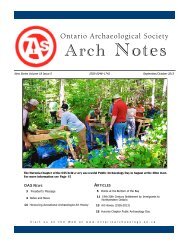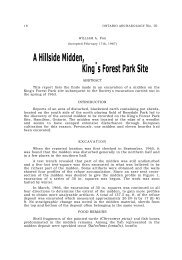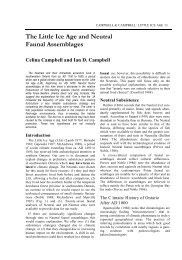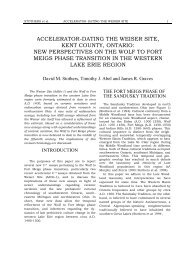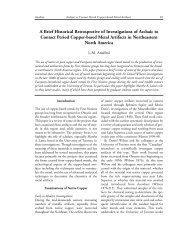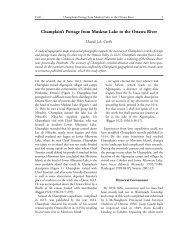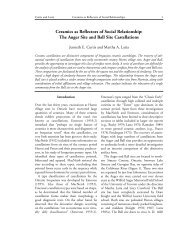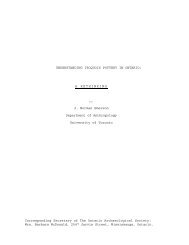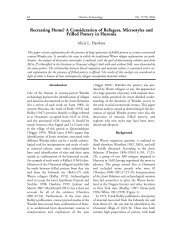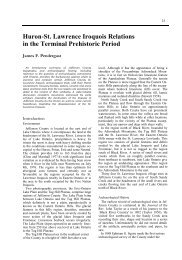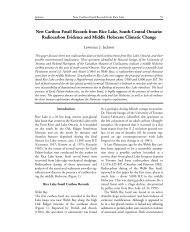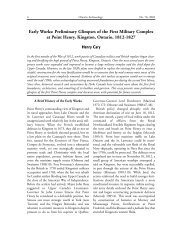August 2011 - OAS Toronto Chapter - Ontario Archaeological Society
August 2011 - OAS Toronto Chapter - Ontario Archaeological Society
August 2011 - OAS Toronto Chapter - Ontario Archaeological Society
- No tags were found...
Create successful ePaper yourself
Turn your PDF publications into a flip-book with our unique Google optimized e-Paper software.
<strong>Toronto</strong> Landscapes : The Carrying PlacesBy Annie VeilleuxHow do people come to know and ascribe meaning to landscape?This is a question that I have been grappling with aspart of my research on ancient Aboriginal trails in <strong>Toronto</strong>.Prior to the imposition of artificial survey grids and straightroads, the landscape north of Lake <strong>Ontario</strong> was covered bya network of interwoven trails along which life was livedfor thousands of years. Aboriginal peoples created these ancientfootpaths through the accumulated imprints of countlessjourneys. The trails were simultaneously shaped bythe natural topography itself, as travellers avoided swampylowlands, rocky outcrops, and other natural impediments.Some of the most well-known trails include the footpath,now long hidden underneath the asphalt of DavenportRoad, which followed the base of the 13,500-year-oldshoreline of glacial Lake Iroquois. Well-known paths alsoinclude a series of north-south routes that connected Lake<strong>Ontario</strong> to the upper Great Lakes by way of Lake Simcoe,the best documented of which followed the Humber Rivervalley. Better known as the <strong>Toronto</strong> Carrying Place, thistrail followed the east branch of the Humber River northwardover the Oak Ridges Moraine to the west branch ofthe Holland River. Sometimes known as the east branchof the <strong>Toronto</strong> Carrying Place, another trail extended fromthe mouth of the Rouge River northwards to the headwatersof the Little Rouge and over the drainage divide to theeast branch of the Holland River at Holland Landing. Stillanother trail followed the Don River. I refer to these threenorth-south trails as the <strong>Toronto</strong> Carrying Places (Figure 1).The history of these ancient footpaths begins with earlyAboriginal peoples who inhabited and visited the northshore of Lake <strong>Ontario</strong>. For thousands of years, Aboriginalchildren learned by following and listening to their eldersas they walked the trails that linked their settlements withhunting, fishing, and harvesting grounds, as well as traderoutes that tied the north shore to northern <strong>Ontario</strong>, theAtlantic coast, and the Midwest. For European newcomers,explorers, fur traders, and settlers alike, the landscapenorth of Lake <strong>Ontario</strong> was entirely foreign, and those whoventured along its ancient trails experienced their newsurroundings step by step. It can never be stressed enoughthat wherever Europeans travelled in what is now the Cityof <strong>Toronto</strong> they did so in the footsteps of countless otherswho went before. In fact, it was a Mississauga mannicknamed ‘Old Sail’ who advised Governor Simcoe andhis crew to venture down the Don River trail, a route thathe knew would be less difficult for the travellers who hadinitially ventured north via the Humber trail. What ‘OldSail’ did not know, however, was that his recommendationwould lead to the obliteration of a trail that had potentiallybeen used by Aboriginal peoples for millennia, as the DonRiver trail would ultimately become the basis for YongeStreet.These landscape features are of great antiquity, yet they stillcontinue to resonate with people today. They continue to becommemorated in the form of plaques and heritage walks,and a new book was just published on the subject (HeatherRobertson’s Walking into Wilderness: The <strong>Toronto</strong> CarryingPlace and Nine Mile Portage). Believe it or not, the ‘<strong>Toronto</strong>Carrying-Place Trail’ even has its own Facebook page(though so far, only one person “likes” it)! How we experiencethese trails today, however, is worlds away from howthey were experienced in the past. While it is impossible forus to re-live the sights, sounds, and smells that were experiencedby those who walked its paths for thousands of years,the trails still hold meaning for many of us today. The aimof my research was to answer a seemingly basic question:what has the <strong>Toronto</strong> Carrying Place meant to the myriadof people who have walked its paths, either physically or intheir imagination, from its earliest inception until today?I suggest that people come to know and make sense of, andultimately ascribe meaning to landscape by living it, bydiscussing it, and by imagining it. Knowing landscape byliving it is defined by on-the-ground physicality, and theintimate sensuous knowledge that is acquired through workand play, or in the case of the <strong>Toronto</strong> Carrying Places,through walking. Knowing landscape by discussing it orcommunicating about it incorporates any story, narrative,place-name, scientific research, or debate, concerning theparticular landscape features. Knowing landscape by imaginingit is rooted in the realm of social memory and historicalconsciousness, and concerns issues of power and representation,iconography and ideology. There is no doubt thatthese three ways of knowing are inextricably intertwinedand more than one can be at play at any one time. By differentiatingbetween these ways of knowing, however, wecan get a better understanding of the overlapping narrativesof the <strong>Toronto</strong> Carrying Places.Like many of the readers of this newsletter, my backgroundis in archaeology. An exploration of the <strong>Toronto</strong> CarryingPlaces, however, necessitated a journey into other disciplinesand the use of a number of various sources, fromarchaeological sites to exploration journals, from oralhistories to commemorative plaques, and from seventeenthcenturymaps to twentieth-century drawings. Individually,these sources might offer only ephemeral informationconcerning the meaning of the trails at a certain time for aProfile 28 (1) <strong>2011</strong> 2
certain people. Taken together, however, theyprovide an enriched narrative for the <strong>Toronto</strong>Carrying Places—one that encompasses thevarious historically-specific, individually-experienced,and culturally-constructed ways thatpeople have come to know and ascribe meaningto these ancient landscape features.Figure 1: <strong>Toronto</strong> Carrying PlacesAnnie Veilleux is a graduate student in the Interdisciplinary Studies Program at York University and a Cultural HeritageSpecialist for the Built Heritage and Cultural Heritage Landscape Planning Division at <strong>Archaeological</strong> Services Inc.Profile 28 (1) <strong>2011</strong> 3
<strong>2011</strong>/2010 Lecture SeriesSeptember 21, <strong>2011</strong>“The Huron-Wendat Feast of the Dead”Dr.Erik R. Seeman, Professor, University of Buffalo.The Feast of the Dead was a ritual of extraordinarypower for the Wendats (Hurons) of present-day <strong>Ontario</strong>.Every decade or so they lovingly scraped thebones of their deceased friends and relatives, whosebodies had decomposed on scaffolds, and reburied thedry bones in an enormous pit. The French Jesuit missionarieswho witnessed this ritual were impressed bythe Wendats’ devotion to their dead.This talk uses the Feast of the Dead – and mortuarypractices more generally – as a way to understandFrench-Native encounters in the seventeenth century.Wendats and French Catholics had surprisingly similarattitudes toward death and human remains. Thesesimilarities allowed for communication between thetwo groups, even as both used death practices to definethe differences with the other. Deathways were thus atthe very heart of the colonial encounter.October 19, <strong>2011</strong>“Archaeology and the Revitalization of the Don ValleyBrick Works” David Robertson, <strong>Archaeological</strong>Services Inc.Between 2005 and 2010, <strong>Archaeological</strong> Services Inc.carried out a series of studies in support of the EvergreenFoundation’s ambitious plans to transform thelargely derelict Don Valley Brick Works site into anatural and cultural heritage site. This work involvedboth archaeological excavations and monitoring ofgeneral construction activities in order to document theburied remains that had accumulated on the site overthe century it was in operation.(Kiln <strong>Toronto</strong> Brickworks, Photo courtesy of DavidRobertson, ASI)Profile 28 (1) <strong>2011</strong> 4
<strong>2011</strong>/2010 Lecture SeriesNovember 16, <strong>2011</strong>Dr. Gary Crawford, University of <strong>Toronto</strong>, MississaugaTBAJanuary 18, 2012Members Night, Please contact speakers coordinator.December <strong>2011</strong><strong>Chapter</strong> party, date to be announced.February 15, 2012Dr. Holly Martelle, Timmins Martelle Consultants,TBAMarch 21, 2012Dr. Max Friesen, University of <strong>Toronto</strong>“Across the Top of North America: The Thule InuitMigration from Alaska to Arctic Canada”One of the central events in the Arctic past revolvesaround the migration of ancestral “Thule” Inuitfrom Alaska to Canada and Greenland around 800years ago. Traveling by boat and dogsled, theseearly Inuit moved across an entire continent in onlya few decades, learning about their new environmentsas they went. In this paper, I will report onnew research which is leading to a re-thinking ofwhen and why this migration occurred, and how theearliest Canadian Inuit lived.April 18, 2012Dr. David Smith, University of <strong>Toronto</strong>, MississaugaTBAMay 16, 2012Dr. Conrad Heidenreich, Professor Emeritus, YorkUniversityTBAProfile 28 (1) <strong>2011</strong> 5
Notice: <strong>Toronto</strong> <strong>Chapter</strong> Bus TourProfile 28 (1) <strong>2011</strong> 6
Upcoming Events and NoticesSeptember <strong>2011</strong>NOTICEFor update, notice, and newsletter distribution purposes, please update your current, active, non-firewalledemails with the <strong>Toronto</strong> <strong>Chapter</strong>. Any bounced emails are referred to the Treasurer for follow-up, but thiswastes club resources. If we cannot contact a member by phone, the Treasurer has to send an inquiry by postageand that takes time. If the individual does not respond, their e-mails continue to bounce. We would liketo ensure that all members are receiving appropriate infomation in a timely fashion. Thanks so much!September 21, <strong>2011</strong>Upcoming LectureThe Huron-Wendat Feast of the DeadThe speaker will be Dr.Erik R. Seeman, Professor at theUniversity of Buffalo.Saturday September 24, <strong>2011</strong>Bus TripAn upcoming bus trip exclusively for <strong>Toronto</strong> <strong>Chapter</strong> membersis set for the Peterborough Petroglyphs Park! Join usfor lunch in Lakefield, a tour of the Petroglyphs, a visit toKawartha County Wines, and a whole lot of fun! Details tobe posted on the chapter website toronto.ontarioarchaeology.on.ca as well as on our Facebook pageOctober 13-16 <strong>2011</strong><strong>2011</strong> <strong>OAS</strong> SymposiumMark your calendars for the annual <strong>OAS</strong> Symposium “Waterways Through Time, Recognition and Celebration” being held in Ottawa this year from October 13 to October 16. . Refer to the <strong>OAS</strong> website for moredetails: http://www.ontarioarchaeology.on.ca/<strong>OAS</strong>symposium/<strong>2011</strong>Symposium.phpProfile 28 (1) <strong>2011</strong> 7
Contact Us!T.<strong>OAS</strong> CONTACT INFORMATIONMailing address:T.<strong>OAS</strong>,<strong>Toronto</strong>’s First Post Office,260 Adelaide Street E., Box 48,<strong>Toronto</strong>, ON, M5A 1N1.President: janiceteichroeb@rogers.comVice-President: latta@utsc.utoronto.caPast President: Sylvia@teaves.comTreasurer: jjrr@sympatico.caRecording Secretary: Annie GouldCorresponding Secretary: CaroleM250@aol.comWeb editor: Janice TeichroebFacebook Administrators: Janice and MimaProfile Editor: amanda.parks@gmail.comCome Visit Our WebsiteWebsite: http://toronto.ontarioarchaeology.on.ca/Also, don’t forget to join the <strong>Toronto</strong> <strong>Chapter</strong> of the <strong>Ontario</strong> <strong>Archaeological</strong><strong>Society</strong> Facebook Group for all the up to date information aboutmeetings and interesting links. Information is also posted on the <strong>Chapter</strong>’swebpage.Profile 28 (1) <strong>2011</strong> 8



